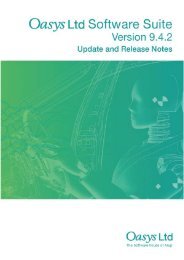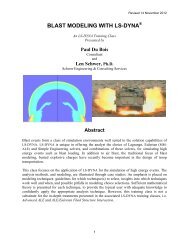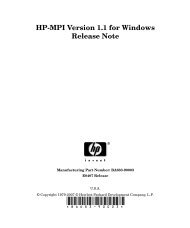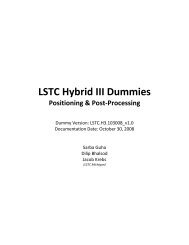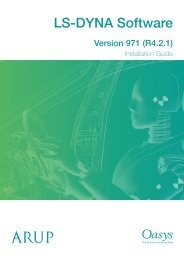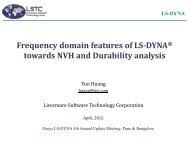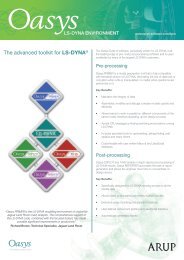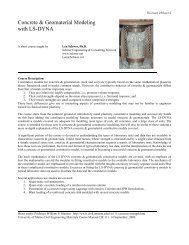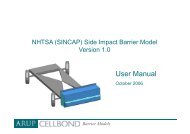Oasys LS-DYNA Environment 8.1 VOLUME 3 ... - Oasys Software
Oasys LS-DYNA Environment 8.1 VOLUME 3 ... - Oasys Software
Oasys LS-DYNA Environment 8.1 VOLUME 3 ... - Oasys Software
You also want an ePaper? Increase the reach of your titles
YUMPU automatically turns print PDFs into web optimized ePapers that Google loves.
<strong>Oasys</strong> <strong>LS</strong>-<strong>DYNA</strong> <strong>Environment</strong>: User Guide (Version <strong>8.1</strong>)<br />
The trimming option is set up using the *DEFINE_CURVE_TRIM option. The trim data can<br />
be either x,y data points (projected into the correct plane using a *DEFINE_VECTOR card as<br />
necessary) or IGES or VDA data contained in a file. An arbitrary number of trim curves may be<br />
specified as long as curves do not intersect and each element is trimmed by only one curve.<br />
Curves may extend outside the part to be trimmed but <strong>LS</strong>-<strong>DYNA</strong> always treats a curve as a<br />
closed loop. Material can be removed either inside or outside the specified line. Note that pretrimming<br />
is also possible using this option by specifying a *ELEMENT_TRIM card; if this card<br />
is not in the deck then trimming occurs at the end of the run. A special procedure is required to<br />
trim an adaptive mesh - see the *INTERFACE_SPRINGBACK card for details.<br />
A users guide to adaptive mesh trimming is available; please contact <strong>Oasys</strong> for more details.<br />
Alternatively, dedicated metal forming pre-processors, such as eta/<strong>DYNA</strong>FORM, are often<br />
capable of trimming a model.<br />
CONTROL CARDS<br />
Certain control card options are suggested for sheet metal forming.<br />
The *CONTROL_SHELL card includes a flag called istupd; this should be set to 1 so that<br />
membrane strains in shells cause thickness changes which is important for sheet metal forming<br />
simulation.<br />
The penalty stiffness value and the thickness flags (including shlthk and ssthk) on the<br />
*CONTROL_CONTACT card interact with the contact definitions and should be checked<br />
carefully. If a non-continuous mesh is used for the tools it may be necessary to increase the<br />
bucket search frequency.<br />
Scaling the tool velocities has been mentioned. It is also possible to speed up the analysis using<br />
the mass scaling options, with the same caveats about dynamic effects. At the simplest level,<br />
mass scaling can be implemented by simply increasing the density of the blank material.<br />
However, the *CONTROL_TIMESTEP card allows a minimum time step to be maintained by<br />
setting dt2ms = negative value of desired timestep (be aware of the mass increase termination<br />
option set on the *CONTROL_TERMINATION card). Mass scaling is easier to implement than<br />
velocity scaling as only one value has to be changed. In practice, “a bit of both” is used, with<br />
modest levels of velocity scaling combined with mass scaling adjusted to check for dynamic<br />
effects.<br />
Adaptive remeshing has already been mentioned and is defined using the<br />
*CONTROL_ADAPTIVE card (and do not forget to set the appropriate flag on the *PART card<br />
for the blank). A tolerance of 5 degrees and three levels of adaptivity are good starting options.<br />
Previously, the more expensive, option to repeat the previous cycle after adaption (adpass=0)<br />
was advisable otherwise new nodes created by adaptivity could be on the “wrong” side of the<br />
contact surface. The latest version of <strong>LS</strong>-<strong>DYNA</strong> allows adaptivity to take place before contact<br />
between blank and tool takes place. This is achieved by setting adpene to a positive value. The<br />
Page 17.7



